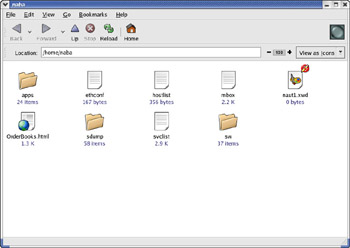Using the Nautilus Shell
Using the Nautilus Shell
Now that you know the basics of the Linux file system, you can explore it. You can access the files and directories in two ways:
-
By using a graphical file manager such as the Nautilus shell in GNOME
-
By typing appropriate Linux commands in a terminal window or a text console
The Nautilus graphical shell is intuitive to use-it is similar to Windows' Active Desktop-and you can perform many tasks such as navigating the file system and performing system-management tasks with Nautilus. You may want to spend a few minutes now exploring the file system by using the Nautilus (the KDE file manager works in a similar manner, so it isn't covered here).
To start Nautilus, double-click the home icon in the upper-left corner of the GNOME desktop (refer to Figure 7-2). Nautilus runs and displays the contents of your home directory, as shown in Figure 7-5.
The Nautilus window is vertically divided into two windows-the left side can show different views of the file system and other objects you can browse with Nautilus; the right side shows the files and directories in the currently selected directory. As you can see from the Location text box along the top of the window, Figure 7-5 shows the content of the /home/naba directory. The title bar shows the name of the currently selected directory.

Figure 7-5: My Home Directory, as It Appears in Nautilus.
If you have used Windows Explorer, you can use Nautilus in a similar manner. Folders represent directories and you can open them by double-clicking. To move to other directories, click the up button on the toolbar as many times as necessary, and then navigate to whichever directory you want to see.
In addition to moving around the file system and viewing contents of directories, you can use Nautilus to perform tasks such as moving a file from one directory to another and deleting a file. I won't outline each step, but you can take a few moments to try the following tasks:
-
To move a file to a different directory, drag and drop the file's icon on the directory where you want the file.
-
To copy a file to a new location, select the file's icon and select Edit>Copy File. You can also right-click the file's icon and select Copy File from the pop-up menu. Then move to the directory where you want to copy the file, and select Edit>Paste Files.
-
To delete a file or directory, right-click the icon, and select Move to Trash from the pop-up menu. To really delete the file, right click the Trashcan icon on the desktop, and select Empty Trash from the pop-up menu.
-
To rename a file or a directory, right click the icon, and select Rename from the pop-up menu. Then, you can type the new name or edit the name.
-
To create a new directory, right-click in an empty area of the right-hand window, and select New Folder from the pop-up menu. After the new folder icon appears, you can rename it by right-clicking and selecting Rename from the pop-up menu.







